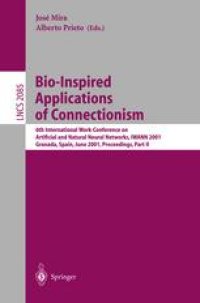
Ebook: Bio-Inspired Applications of Connectionism: 6th International Work-Conference on Artificial and Natural Neural Networks, IWANN 2001 Granada, Spain, June 13–15, 2001 Proceedings, Part II
- Tags: Computation by Abstract Devices, Algorithm Analysis and Problem Complexity, Artificial Intelligence (incl. Robotics), Neurosciences, Neurology, Computer Appl. in Life Sciences
- Series: Lecture Notes in Computer Science 2085
- Year: 2001
- Publisher: Springer-Verlag Berlin Heidelberg
- Edition: 1
- Language: English
- pdf
Underlying most of the IWANN calls for papers is the aim to reassume some of the motivations of the groundwork stages of biocybernetics and the later bionics formulations and to try to reconsider the present value of two basic questions. The?rstoneis:“Whatdoesneurosciencebringintocomputation(thenew bionics)?” That is to say, how can we seek inspiration in biology? Titles such as “computational intelligence”, “arti?cial neural nets”, “genetic algorithms”, “evolutionary hardware”, “evolutive architectures”, “embryonics”, “sensory n- romorphic systems”, and “emotional robotics” are representatives of the present interest in “biological electronics” (bionics). Thesecondquestionis:“Whatcanreturncomputationtoneuroscience(the new neurocybernetics)?” That is to say, how can mathematics, electronics, c- puter science, and arti?cial intelligence help the neurobiologists to improve their experimental data modeling and to move a step forward towards the understa- ing of the nervous system? Relevant here are the general philosophy of the IWANN conferences, the sustained interdisciplinary approach, and the global strategy, again and again to bring together physiologists and computer experts to consider the common and pertinent questions and the shared methods to answer these questions.
This book constitutes, together with its companion LNCS 2084, the refereed proceedings of the 6th International Work-Conference on Artificial and Natural Neural Networks, IWANN 2001, held in Granada, Spain in June 2001. The 200 revised papers presented were carefully reviewed and selected for inclusion in the proceedings. The papers are organized in sections on foundations of connectionism, biophysical models of neurons, structural and functional models of neurons, learning and other plasticity phenomena, complex systems dynamics, artificial intelligence and cognitive processes, methodology for nets design, nets simulation and implementation, bio-inspired systems and engineering, and other applications in a variety of fields.